 Figure 1. Minesweeper detonates
Figure 1. Minesweeper detonatesa mine.
 Introduction to
Naval Weapons Engineering
Introduction to
Naval Weapons EngineeringUnderwater Weapons

a mine.
Underwater Explosions
Explosive detonations which occur underwater create shock
waves in a similar manner to explosions in air. Due to the elastic
properties of water, the shock wave tends to be of shorter duration,
but with a proportionally larger peak overpressure. The energy
in the underwater shock wave attenuates very quickly with range.
Therefore, the shock wave from an underwater explosion does not
cause the same level of damage as one would expect from studying
explosions in air. This is not to say that there are no effects
from underwater shock waves.
Targets exposed to underwater shock waves will be subject
to diffraction and drag loading just like in air. There will
be very little translation of targets because the shock wave is
of short duration, and objects in motion will quickly be brought
to rest by drag in the water. Diffraction loading applies, but
targets that are in the water tend to be well-designed to withstand
the type of loading that occurs. Therefore, very little damage
is done directly by these mechanisms. Considerable damage can
still occur due to internal equipment failure and missile hazards
(things thrown through the air inside the ship). To be the most
effective, underwater warheads utilize the interaction of the
steam void created by the explosion with the hull of the target.
There are two distinct cases: surface and submerged bodies.
When a warhead is detonated at close range beneath a ship,
the steam void initially lifts the ship upwards from the middle.
This tends to weaken the ship's keel. After the steam void has
reached its maximum volume the surrounding water pressure will
collapse it. The ship then falls into the void, still supported
on its ends. The keel will then break under the ship's own weight.
The compression of the steam void will raise the temperature
and the bubble will oscillate a few times. The ship may be destroyed
during the subsequent oscillations if it manages to survive the
first.
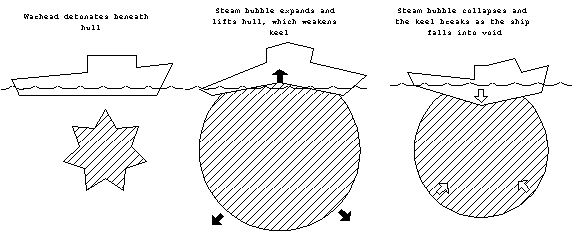
When used against a submerged target, the greater ambient pressure
and the buoyancy of the surrounding water preclude effective uses
of this technique. However the interaction of the steam void
and the submerged hull can be exploited to severely damage or
potentially breach the submarine's pressure hull. The process
begins with a close range underwater explosion. If the steam
void contacts the hull it will attach itself. In this location,
the oscillation of the steam void will cause a cyclic stress to
the submerged hull and weaken or breach it. If a submarine's
pressure hull is compromised it is unlikely to survive.
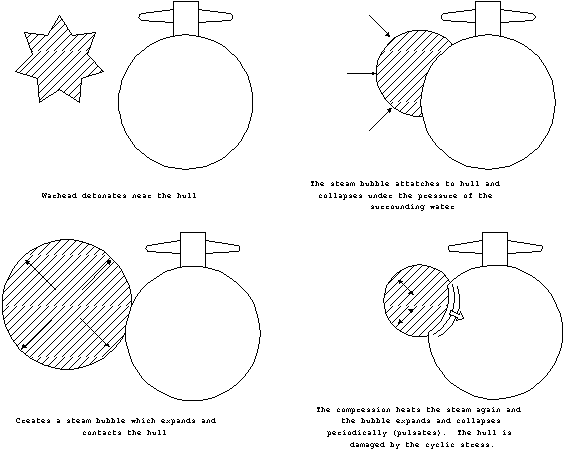
hull.
Depth charges are underwater bombs. They are set to detonate
at a prescribed depth. They must be dropped directly on the submarine
to be effective. The primary goal in their use is not to sink
the submarine, but rather to take it out of action. The ambient
noise created by their use will generally deny the submarine the
use of sonar. Furthermore, the shock wave may disable internal
equipment that could take the submarine out of action. For example,
the shock wave may damage torpedo launching equipment or vital
propulsion related machinery. Depth charges are typically either
thrown over the side, shot out of cannons, or are rocket-propelled.
All methods have limited range and accuracy.
Torpedoes
Torpedoes are self-contained weapon systems. At the low
end of sophistication, they are straight-running underwater bombs.
At the high end, they have active and passive sonar seekers,
and can be guided remotely or send telemetry information over
a thin wire back to the launch platform. A typical torpedo looks
like this:
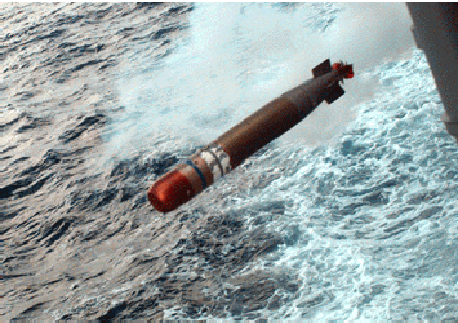
being launched from surface ship.
The torpedo sub-sections (from forward to aft) are:
1.) Nose section. This section contains the acoustic
tracking system. It also houses the electronic guidance computer.
2.) Warhead section. This section contains the target
sensing mechanism. Usually torpedo fuses detect either impact
or the magnetic field of the target (see the discussion on mines
for magnetic influence sensing). The warhead also contains the
main explosive charge. Modern lightweight torpedoes (dropped
from aircraft) carry about 100 lbs. of explosive and heavyweight
torpedoes pack in excess of 1000 lbs.
3.) Propulsion section. This section contains either
electric motor and battery or combustion engine and fuel. The
fastest torpedoes use combustion engines. In this case, the
performance is limited by depth due to the back-pressure the engine
exhaust must work against. Modern torpedoes can travel in excess
of sixty nm/hr (knots).
4.) Tail section. This extreme after section contains
the control surfaces and propeller.
Sea Mines
Mine warfare continues to be one of the most effective
means to deny use of a particular area to the enemy's ships and
submarines. Mines can be inexpensive and therefore numerous.
Mines can detect the target's presence through three methods:
magnetic, pressure, and acoustic influence. Many mines can use
all three in any combination. Magnetic influence mines sense the
permanent magnetic field causes by the iron in the ship's hull.
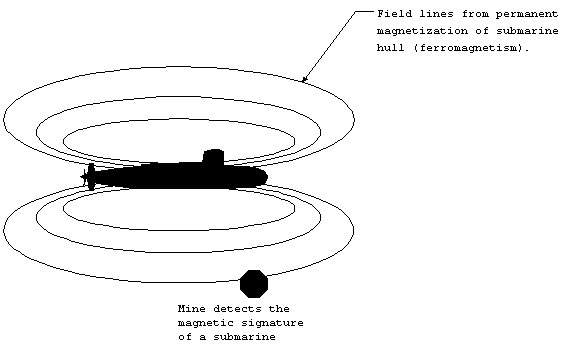
sensing.
The magnetic field of a ship can be controlled by periodically
degaussing the ship. However, this is a time consuming process
which involves wrapping the entire hull in large cables and applying
a magnetic field for several hours. Most ships therefore have
some detectable magnetic field and are vulnerable to magnetic
influence mines. Only ships made out of wood or fiberglass are
considered immune. Furthermore, the mine can be made to differentiate
different types of targets on the basis of their magnetic "signature."
Mines can also detect targets by the wake they create
in the water. As the ship moves through the water, a pressure
wave is formed which is visible as a wake on the surface. The
same thing occurs underwater but is not visible. The pressure
wave can be detected by a mine, however. The faster the ship
is moving, the greater the effect.
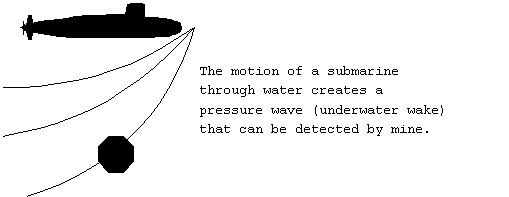
sensing.
Lastly, the mine may contain sonar equipment to detect the acoustic
"signature" of the ship. This too allows the mine to
distinguish between many different types of targets.
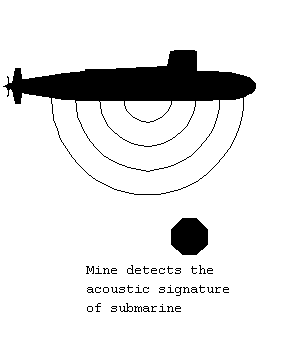
sensing.
There are two main types of sea mines in use: bottom and moored.
Bottom mines rest on the ocean floor. They can be deployed
from aircraft, submarines or ships, although deployment from surface
ships is rare. In shallow water they are effective against surface
ships and in deep water against submarines.
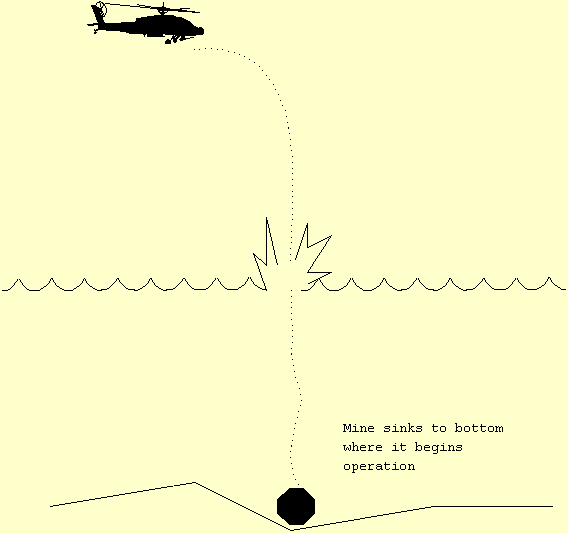
mine.
A moored mine has two parts: an anchor and the mine case. Once
deployed (either by aircraft or submarine), the mine case leaves
the anchor and deploys to a preset depth. The anchor keeps the
mine from drifting.

of mines.
The submarine deploys the mine by launching it out of a torpedo
tube. Some mines have a limited capacity to travel on their own
("swim") and are used to deploy mines into regions where
it is too shallow or dangerous for the submarine to operate.
Other mines simply drop to the ocean floor and deploy.
Another variation is the "captor" mine, which
is a bottom mine that releases a lightweight torpedo when the
target is detected. The torpedo increases the range of the mine.
When the torpedo is deployed it begins a circular search pattern
using active sonar to look for the target.
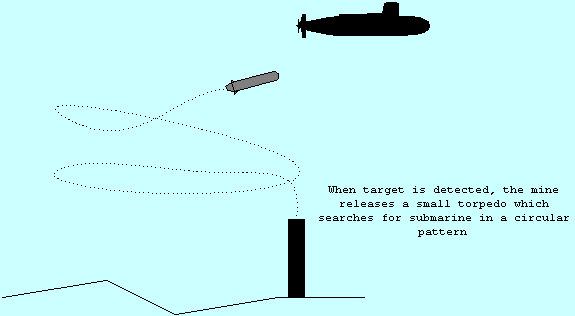
Mines come in a variety of warhead sizes, from a few hundred to
a few thousand lbs. of explosive. It should also be noted that
drift mines, that is, mines which float freely in the current,
are not discussed since their use is prohibited by international
law.
Mine Clearing
Removing sea mines is a difficult and dangerous mission.
There are three main methods:
Cable cutting. This method is used to clear moored mines.
A sled with a cable cutting mechanism is towed through the mine
field by a helicopter. The sled cuts the mine case free from their
anchors, which are then collected by the mine sweeper. The mine
may be detonated by EOD personnel (by placing an explosive charge
on the mine) or sunk by gunfire (shooting the mine may cause it
to detonate, but not in every case).
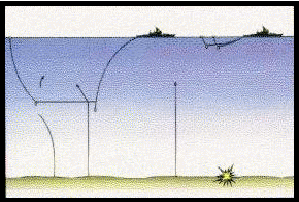
sleds.
Detonation by towed sled. The sled is towed by a helicopter
as in the first case. This sled is designed to simulate the magnetic,
acoustic and pressure signatures of the expected target in order
to detonate the mine. The sled is generally of robust construction
so that is not destroyed in the process. May not be effective
against sophisticated mines which are looking for specific signatures
in combination or have delay features which count a specific number
of targets before detonation.
Remotely operated robotic vehicles. This process resembles
conventional bomb disarming. The robot vehicle has cameras which
broadcast video to a controller. The robot may be used to cut
the mine free, disarm the mine, or disrupt it. Disrupting is the
use of small amount of explosive to separate the fuse from the
explosive charge.
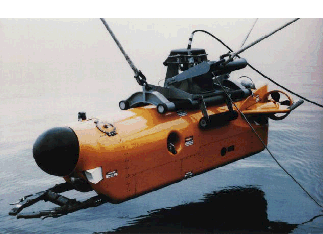
robotic mine clearance device.